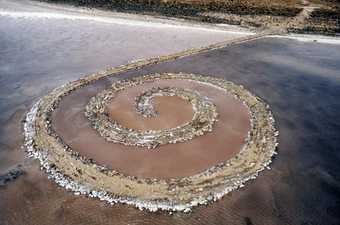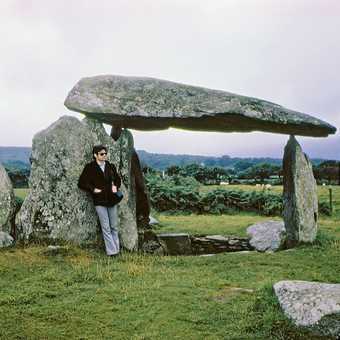“I think that’s more or less run its course – the typical idea of exhibitions in a museum,” Robert Smithson told me in conversation in 1971. “I think it would be quite possible to make art in a quarry, a mine, a lake, or canal – you know, any number of places. To build directly out of the ground of the site is one of my intentions.”
In fact, he had already done it. Smithson built his land art milestone Spiral Jetty in 1970. It had appeared on the cover of Artforum almost immediately. Gianfranco Gorgoni’s photographs, including the iconic shot on the front page, instantly persuaded most people who saw them that they reported an epochal work, one that might revise the terms of ambition for future sculpture.
But events kept Smithson from compounding the eccentric brilliance of Spiral Jetty. In 1973, with many of his plans for earthworks unrealised, he died at 35 in the crash of the small aircraft from which he was inspecting his work-in-progress, Amarillo Ramp, a piece later completed by his widow Nancy Holt and friends, Richard Serra among them. Other important American works of land art followed, by Michael Heizer, Walter de Maria and others. But Spiral Jetty so far remains sui generis, or so the photographs have always suggested.
Smithson foresaw that the remoteness of the desert site, on the uninhabited north shore of Utah’s Great Salt Lake, would keep visitors to a minimum. He made the half-hour film The Spiral Jetty 1970 – part documentary, part ancillary artwork – to guarantee the earthwork some kind of foothold in public memory, regardless of how many people made the trek to see it. And no one who sees the film, a dazzling reverie sprung from Smithson’s fascination with geology, paleontology, astronomy, mythology and cinema, ever forgets it. I have seen it six or seven times in 35 years, but I finally visited the Jetty itself only last September.
By 1976, the water level of the Great Salt Lake had risen enough to submerge the work completely. Except for a brief period during the late 1990s, it seldom re-emerged – until recently.
Last July, a mail had arrived at my office announcing a “Spiral Jetty Weekend”, co-hosted by the International Sculpture Centre and the Salt Lake Art Centre. The programme included organised visits to the site on successive days, with an evening panel discussion of Smithson’s art sandwiched between them.
Salt Lake City is known the world over as the centre of the Mormon church, formally called The Church of Jesus Christ of Latter Day Saints. Reportedly, about half the city’s population, and a considerably larger fraction of the state’s residents, professes the Mormon faith. We dwellers in America’s godless coastal cities get a time-travel sort of shock when we visit the heartland and find it punctuated with roadside crosses and billboards forecasting imminent apocalypse and promising salvation to the repentant. The nation’s vast mid-section seems to lack all sense of the United States as an Enlightenment project. But despite that, and despite Salt Lake City’s town plan centring on the Mormon Temple, the casual American visitor to Utah comes away more impressed by the influence of the aerospace industry than by the region’s peculiar Wild West strain of messianic Christianity.
Riding out to Spiral Jetty in a chauffeured van full of other first-time visitors, some of them locals, I saw a sign drift by near a roadside exit. It read “Thiokol” in the white-on-green Helvetica format reserved for place names in official American highway signage. I asked a fellow passenger, a Salt Lake City heart specialist, about it, because I knew the name only as part of the corporate moniker of a major military contractor, Morton Thiokol, manufacturer of rocket engines and other environmentally unfriendly products. Sure enough, the town owes its name to the company. Elsewhere along the route, for hundreds of yards at a stretch, high concrete baffles flank the roadside. These, our well-informed companion told us, are blast deflectors. Should one or more of the rocket fuel storage units behind them explode, they will divert the blast upward, giving passing drivers a speeder’s chance of evading harm.
The drive from Salt Lake City to Spiral Jetty takes at least two hours. Outbound, the last rest stop occurs about three quarters of the way to the site, at the Golden Spike National Historic Monument. Here, at a small theme park attached to a visitor centre, costumed performers and short trains powered by antique steam locomotives regularly re-enact the 1869 ceremony that marked completion of the world’s first transcontinental railroad. In fact, the builders of the original eastbound and westbound tracks almost missed connecting by several miles. But the ceremony reforges over and over the legend of their meeting without mishap at the intended spot.
The previous day’s visitors to the Jetty had told us they returned exhausted by withering, windless heat. But the weather had changed overnight. Cold, relentless winds forced most of us to don extra layers when we stopped. At the last fork in the road before the site, a small hand-painted sign with an arrow pointed the way. Noticing it produced a shiver of unease. No one wants to see Spiral Jetty go the way of the Golden Spike. Many of us were anxious about the aspect of pilgrimage in our outing: we had no wish to be the first wave of a slowly gaining tourist onslaught. When the work resurfaced last year, following years of drought, the Salt Lake City newspaper ran a big feature story about it. But most locals still seem to regard it as a late 1960s oddity, wrought by an outsider, though a point of pride merely because of the world’s inexplicable interest in it.
Obedient to the rules of access, our vehicles parked about a quarter of a mile from the Jetty. We walked the last stretch, several of us following the advice of earlier visitors to climb the rocky hill that overlooks Rozel Point, whence the sculpture springs, and approach it “from above”. Stiff, barbed creosote bushes fill the gaps among the sharp, basaltic rocks that cover the hillside, ripping at trousers and exposed ankles. The wind surged even more fiercely as the few of us who took the slope gained elevation, but the effort of climbing generated an inner heat that felt like fever in combination with the chilly blasts from without.
When I surmounted the ridge that overlooks the work, I had a similarly visceral experience of the situation’s impact, struggling for balance against the wind and awed by the spectacle below. The rugged stone-strewn slope appeared to promise only a fatal tumble. It took me half an hour to pick my way down to the lakeshore level again. But there lay Spiral Jetty, no longer the salt-rimmed spiral prominence pervaded by blood-red water that Smithson described, but a white-on-white relief improbably evocative of Malevich in its ambition to position itself in a cosmic frame.
Whenever the water of the lake recedes, it leaves salt in its wake. After the recent long drought, it now encrusts almost every inch of the work and a salt bed has risen and hardened within its 1,500ft-long spiral. It appears inevitable that after a few more cycles of high water and drought – probably a matter of decades – the Jetty will disappear completely within a matrix of impacted salt: an art conservation problem for the ages.
We visitors could see the process underway. The deep water lay far out in the lake bed, a roseate sea rippling away for miles, its surface torn into whitecaps by the wind. Between the Jetty and the water’s edge were scudding, tumbleweed-like plumes and quivering masses of salt foam, the latter in various stages of coalescence into the hard white ground, still tinged with rosy algae, on which we walked and stood. Despite the facts, I kept imagining the lake bed and the work as being ice-bound rather than salt-bound, so white has the setting become. Spiral Jetty was not even 35 years old when I saw it, yet the mind could easily accept the thought of it as 3,500 or 35,000 years old. Only a nearby derelict oil rig, the ruins of a speculator’s failed scheme, provides some anchorage in time for the disorientated visitor. That, and the presence of other visitors. Seeing the work from the nearby ridge, dotted with 30 or 40 people, created a slightly sickening sense both of humankind’s unstoppable dispersal across the planet and of the planet’s, and the larger universe’s, utter obliviousness.
The idea of the spiral goes way back in human culture to the earliest rock inscriptions in the American south-west, for example. Smithson saw mentioned its occurrence in the disposition of galaxies and nebulae, in the fine structure of crystals, in the human ear and in Constantin Brancusi’s famous abstract portrait of James Joyce as a spiral adjoined by a vertical.
In writings and conversation, its creator emphasised the difficulty of getting a fix on the scale of the Jetty. Now I knew how literally he meant it. From up on the ridge, the sculpture looks gargantuan in its prehensile hold on the lake bed. But set foot on it, and it turns almost intimate, a mere filigree of earth-moving within a desert immensity that lacks all familiar cues to the sizes and distances of things.
Had Smithson lived and earned the sort of celebrity bestowed on contemporary artists in part to neutralise the truly disturbing things they occasionally make, we might be able to dismiss Spiral Jetty as a colossal projection of ego. Of course, getting it made did require the artist to impose himself on quite a few people. But those who visit the piece tend to come away, as I did, convinced of its success in very different terms: as a monument to artistic self-effacement, in a spirit Katherine Hayles, professor of English at the University of California, likes to call “post-human”. Not the dignified detachment of classicism, but a kind of self-annihilation through fearless embrace of our common existential situation as frail, short-sighted creatures lost in space on a temporarily lucky planet – a situation that embarrasses the triviality of most things that matter to us and the grandiosity of our feelings about them.
Spiral Jetty, for all its rough magnificence, goes nowhere. We need more than ever its nested reminders that further self-involvement will not save us, as individuals, as a society, or as a species.


